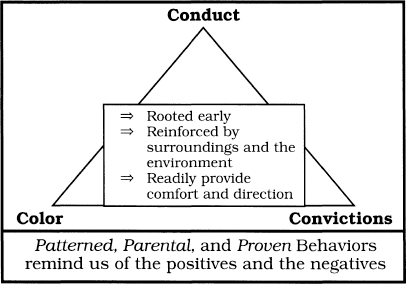As I said, the understanding of others begins only after we understand and take a close look at ourselves. What we are and what we say and do are based on our experiences and exposures. Let's look at the following:

The chart is not as complicated as it appears. Let's add clarity through definition.
The Conduct we display is evidenced in the various situations in which we are placed.
• At a rock concert I may stand and sing. Where I work I wouldn't think of letting anyone see that side of me.
We tend to Color things based on the ideas, ideals, and biases developed in each of us as a result of our culture, our geographical environment, and our teachings.
• He is from the South, so he must be a bigot and not very smart.
Our Convictions are the “actuals.”
• If we see a rock, we call it a rock.
All three have in common the fact that they are patterned, parental, and proven.
Patterned Behavior
Patterned behavior is “mirrored.” That is, a person will tend to emulate the behavior of someone they respect or admire.
Parental behavior is copied. If a parent is college educated, the son or daughter is more likely to want to go to college. If the parent is a strong disciplinarian, chances are that the child will display the same attribute later in life.
Proven Behavior
Proven behavior develops from the college of hard knocks. If I touch a hot stove, I know I will get burned.
These behaviors have three things in common:
(1) They take root early in our lives . Our formative years are generally birth to the mid-teens.
(2) They are continually reinforced by the environment and our surroundings, where we grow up, what we see others do, and how they react.
(3) They readily provide comfort. We tend to fall back on those things that are comfortable to us.
In each type of behavior, there is both positive and negative. I'll use myself as an example. First, my Positive relates to the sixties. I have great memories of that time period. High school was fun. The Motown sound had just burst onto the scene. To this day, when I hear a Motown song on the radio, I have to crank up the volume; it reminds me of an enjoyable time in my life. Vietnam does not. It is my Negative.
This brings us to the point of this review.
The only constant is change
We cannot change, we will not change, unless we recognize and deal with our own biases.
Ask yourself the following questions and record your answers. Be honest with your responses.
(1) Do I treat everyone as I would like to be treated?
(2) Do I look at those I work with, regardless of race or gender, as learned business associates instead of as objects of my biases?
(3) Do I take the time to understand the individual needs of my associates?
If the answer is “no” or even a qualified “maybe,” develop your action plan by asking yourself, What am I going to do about it? Get others to help you. Ask for their feedback. You should go no further in this book until you have challenged your perceptions.
